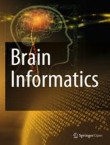Citation Impact 2023
Source Normalized Impact per Paper (SNIP): 1.543
SCImago Journal Rank (SJR): 1.016
Speed 2023
Submission to first editorial decision (median days): 13
Submission to acceptance (median days): 128
Usage 2023
Downloads: 302,950
Altmetric mentions: 141
Improving Likert scale big data analysis in psychometric health economics: reliability of the new compositional data approach
Bipolar psychometric scales data are widely used in psychologic healthcare. Adequate psychological profiling benefits patients and saves time and costs. Grant funding depends on the quality of psychotherapeuti...





